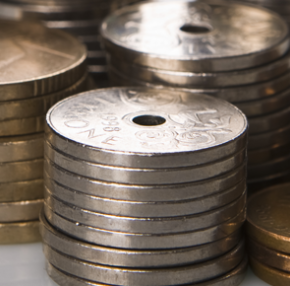Solid price growth in PPI by year’s beginning
Published:
The producer price index (PPI) increased by 5.3 per cent in January. An increase in prices on several energy goods contributed strongly to this increase. The prices on electricity had the largest percentage wise increase.
- Full set of figures
- Producer price index
- Series archive
- Producer price index (archive)
If one excludes energy goods, PPI showed a small upturn of 0.3 per cent. Prices on energy goods in total ended with a large increase of 14.4 per cent. An important contributor here came from electricity, gas and steam. Prices here increased by 41 per cent in January. According to the weekly reports (in Norwegian) from the Norwegian Water Resources and Energy Directorate (NVE), the increase came as a result of several factors, mainly due to the weather conditions. Lower temperatures led to higher consumptions, and week 2 showed the largest weekly consumption since 2008. In addition, there has been weak winds in the Nordic countries and low amounts of rainfall in Norway. This has contributed further to the price increase. As a dampening factor, there was a relatively large downturn in prices on distribution (in Norwegian) on 3,9 per cent.
The prices on crude oil and natural gas are also very important energy goods, and thus important for PPI. The price on crude oil gained a new increase in January and was accompanied by a large increase in natural gas prices. Combined, these two got a positive price change of 11.7 per cent. Services related to these two industries, however, had a downturn of 2.8 per cent. The last segment of the energy goods, refined petroleum products, went up 7.3 per cent. This is partly explained, as with electricity, with the cold weather in Europe in January.
Increases within manufacturing
Prices within manufacturing increased by 1.3 per cent in January. If one takes away the refined petroleum products, this increase was more moderate, at 0.6 per cent. Both the metal industry and the machine industry saw increases.
The food industry did not contribute to the increase in manufacturing. This important group had a price fall of 0.9 per cent. Its largest subgroup is the sea food industry, which got a downturn of 1.6. On the export market, seafood is all but dominating, and here it had a decrease of 3.2 per cent. Also, the beverage industry had a downturn with 1.5 per cent combined for both markets.
The metal industry, which is very important on the export market, had a combined upturn of 0.8 per cent, the contributions comes both from non-ferrous metals such as aluminum and zinc, but also from increased prices on steel on the world market. The machine industry had an increase of 0.9 per cent.
Equally as interesting is the relatively large twelve-month growth in both the metal industry and the machine industry. In total the prices increased from January 2020 to January 2021 by 9.7 per cent and 4.4 per cent, respectively.
Figure 1. Price index. 2015=100
| Manufacturing total | Metal industry | Machine industry | |
| Jan. 2015 | 98.91 | 105.06 | 102.89 |
| Feb. 2015 | 99.78 | 104.14 | 102.83 |
| March 2015 | 100.54 | 106.62 | 98.13 |
| April 2015 | 100.79 | 103.67 | 97.95 |
| May 2015 | 100.94 | 102.19 | 98.5 |
| June 2015 | 101.09 | 101.81 | 98.57 |
| July 2015 | 101.19 | 99.6 | 98.31 |
| Aug. 2015 | 100.04 | 96.78 | 98.43 |
| Sep. 2015 | 98.83 | 96.18 | 98.51 |
| Oct. 2015 | 99.24 | 95.74 | 98.77 |
| Nov. 2015 | 99.83 | 95.1 | 103.54 |
| Dec. 2015 | 98.81 | 93.12 | 103.56 |
| Jan. 2016 | 97.5 | 91.9 | 102.73 |
| Feb. 2016 | 96.82 | 90.73 | 102.66 |
| March 2016 | 97.05 | 90.42 | 102.65 |
| April 2016 | 97.8 | 89.22 | 102.62 |
| May 2016 | 99.23 | 89.69 | 102.62 |
| June 2016 | 100.38 | 89.74 | 102.62 |
| July 2016 | 101.7 | 93.34 | 102.65 |
| Aug. 2016 | 100.52 | 96.52 | 102.78 |
| Sep. 2016 | 100.04 | 95.05 | 102.73 |
| Oct. 2016 | 100.55 | 93.67 | 102.43 |
| Nov. 2016 | 101.39 | 96 | 102.44 |
| Dec. 2016 | 102.1 | 98.73 | 102.67 |
| Jan. 2017 | 104.12 | 100.86 | 104.02 |
| Feb. 2017 | 106.06 | 105.36 | 104.19 |
| March 2017 | 105.53 | 107.71 | 104.13 |
| April 2017 | 105.84 | 110.5 | 103.79 |
| May 2017 | 105.71 | 111.15 | 103.72 |
| June 2017 | 105.02 | 110.01 | 103.93 |
| July 2017 | 104.43 | 110.04 | 103.91 |
| Aug. 2017 | 104.36 | 110.27 | 103.21 |
| Sep. 2017 | 105.72 | 111.99 | 103.29 |
| Oct. 2017 | 106.19 | 110.25 | 103.37 |
| Nov. 2017 | 107.45 | 116.62 | 103.41 |
| Des. 2017 | 109.12 | 118 | 103.5 |
| Jan. 2018 | 110.1 | 118.54 | 103.62 |
| Feb. 2018 | 110.04 | 122.26 | 103.63 |
| March 2018 | 109.9 | 121.81 | 103.69 |
| April 2018 | 110.39 | 121.87 | 103.79 |
| May 2018 | 112.81 | 125.09 | 104.34 |
| June 2018 | 113.98 | 127.44 | 104.64 |
| July 2018 | 113.87 | 124.88 | 104.77 |
| Aug. 2018 | 113.46 | 122.72 | 105.53 |
| Sep. 2018 | 113.56 | 121.53 | 105.35 |
| Oct. 2018 | 115.04 | 120.6 | 105.24 |
| Nov. 2018 | 114.85 | 119.46 | 105.97 |
| Dec. 2018 | 113.12 | 118.64 | 106.16 |
| Jan. 2019 | 112.51 | 119.85 | 107.15 |
| Feb. 2019 | 113.64 | 120.33 | 108.14 |
| March 2019 | 114.03 | 121.64 | 108.18 |
| April 2019 | 114.88 | 121.61 | 108.4 |
| May 2019 | 115.07 | 120.33 | 108.54 |
| June 2019 | 114.17 | 119.2 | 108.67 |
| July 2019 | 112.94 | 118.36 | 108.7 |
| Aug. 2019 | 113.01 | 121.3 | 108.93 |
| Sep. 2019 | 112.88 | 125.72 | 109.3 |
| Oct. 2019 | 114.66 | 128.1 | 109.39 |
| Nov. 2019 | 115.2 | 125.96 | 109.48 |
| Dec. 2019 | 116.04 | 124.4 | 109.53 |
| Jan. 2020 | 116.4 | 121.1 | 109.62 |
| Feb. 2020 | 117.97 | 122.44 | 112.18 |
| March 2020 | 116.45 | 124.97 | 112.41 |
| April 2020 | 113.3 | 127.45 | 113.74 |
| May 2020 | 111.35 | 126.81 | 113.69 |
| June 2020 | 111.71 | 122.75 | 112.84 |
| July 2020 | 112.63 | 121.73 | 113.33 |
| Aug. 2020 | 112.67 | 121.89 | 113.37 |
| Sep. 2020 | 112.71 | 124.32 | 113.28 |
| Oct. 2020 | 113.03 | 125.98 | 113.64 |
| Nov. 2020 | 114.28 | 129.13 | 113.62 |
| Dec. 2020 | 114.71 | 131.79 | 113.43 |
| Jan. 2021 | 116.18 | 132.79 | 114.43 |
Updated weights for 2021
The PPI is calculated as a weighted mean of price changes. For the PPI to best reflect the structure of the Norwegian industry, the weights are updated each year. The new weights take effect from January.
The biggest decrease in weight shares from last year is found in extraction of natural gas. The export value decreased by approximately 80 billion NOK from 2019 to 2020, making for a weight decrease of about 8 percentage points, while the weight share of crude oil extraction is marginally lower than last year. The weight shares of other energy goods are decreasing as well, by 7,7 percentage points.
The manufacturing industries' share of the total PPI weights increased from 57 per cent last year to 62 per cent this year. This is mainly due to an increase in the food industry. Also, extraction related services and repair and installation of machinery and equipment contributed to the increased weight within the manufacturing industries.
Fact sheet
Contact
-
Håvard Georg Jensen
-
Elisabeth Mælum
-
Mats Halvorsen
-
Statistics Norway's Information Centre



